New advance for detection of tree heights with satellite imagery
The pixel size of satellite imagery is getting finer and finer in the last decade with the development spaceborne cameras. What is in store for Earth observations if the 10-cm satellite imagery is available in near future? Forest remote sensing scientists believe it may open a new era for the detection of tree heights.
Scientists from the Aerospace Information Research Institute (AIR), Chinese Academy of Sciences (CAS), have proposed a new algorithm called AGAR, which makes it possible to detect tree heights only using 10-cm stereoscopic imagery, according to a study published in Remote Sensing of Environment on May 10.
Tree heights are important structural parameters reflecting forest productivity and health, and they play a key role in assessing forest ecological services and functions in terms of biodiversity and forest carbon stock.
Elevations derived from stereoscopic imagery are a blend of ground surface with heights of forest stands. No new methods have been identified to overcome the challenge of measuring topography beneath dense vegetation cover, although the deciduous forest could be described by leaf-off stereoscopic imagery, and sparse forests could be described through changes in sun elevation angles. It is currently impossible to separate terrain elevations with forest heights only using stereoscopic imagery due to the occlusion of forest canopies and the limited penetration capability of passive optical imagery.
Current stereoscopic imagery is obtained based on the analysis of satellite images with spatial resolutions of 15 meters to 2 meters. Changes of ground surface elevations are in the same scale with that of forest stand heights under this spatial resolution. It is indeed difficult to separate them at this viewpoint.
Scientists found that 10-cm stereoscopic imagery enabled the separation of the mixture at the scale of trees instead of forest stands by making use of image segmentations and allometric equations. Validation results using UAV stereoscopic imagery under different terrain conditions showed the AGAR algorithm could effectively separate terrains from forest heights, and is capable of providing more reasonable predictions of tree heights with minimal influence from terrains.
“This study could contribute to spaceborne stereoscopic imagery on forest vertical structures in the future,” said Prof. Ni Wenjian, corresponding author of the study.
More information:
Tianyu Yu et al, Extraction of tree heights in mountainous natural forests from UAV leaf-on stereoscopic imagery based on approximation of ground surfaces, Remote Sensing of Environment (2023). DOI: 10.1016/j.rse.2023.113613
Citation:
New advance for detection of tree heights with satellite imagery (2023, May 22)
retrieved 22 May 2023
from https://phys.org/news/2023-05-advance-tree-heights-satellite-imagery.html
This document is subject to copyright. Apart from any fair dealing for the purpose of private study or research, no
part may be reproduced without the written permission. The content is provided for information purposes only.

The pixel size of satellite imagery is getting finer and finer in the last decade with the development spaceborne cameras. What is in store for Earth observations if the 10-cm satellite imagery is available in near future? Forest remote sensing scientists believe it may open a new era for the detection of tree heights.
Scientists from the Aerospace Information Research Institute (AIR), Chinese Academy of Sciences (CAS), have proposed a new algorithm called AGAR, which makes it possible to detect tree heights only using 10-cm stereoscopic imagery, according to a study published in Remote Sensing of Environment on May 10.
Tree heights are important structural parameters reflecting forest productivity and health, and they play a key role in assessing forest ecological services and functions in terms of biodiversity and forest carbon stock.
Elevations derived from stereoscopic imagery are a blend of ground surface with heights of forest stands. No new methods have been identified to overcome the challenge of measuring topography beneath dense vegetation cover, although the deciduous forest could be described by leaf-off stereoscopic imagery, and sparse forests could be described through changes in sun elevation angles. It is currently impossible to separate terrain elevations with forest heights only using stereoscopic imagery due to the occlusion of forest canopies and the limited penetration capability of passive optical imagery.
Current stereoscopic imagery is obtained based on the analysis of satellite images with spatial resolutions of 15 meters to 2 meters. Changes of ground surface elevations are in the same scale with that of forest stand heights under this spatial resolution. It is indeed difficult to separate them at this viewpoint.
Scientists found that 10-cm stereoscopic imagery enabled the separation of the mixture at the scale of trees instead of forest stands by making use of image segmentations and allometric equations. Validation results using UAV stereoscopic imagery under different terrain conditions showed the AGAR algorithm could effectively separate terrains from forest heights, and is capable of providing more reasonable predictions of tree heights with minimal influence from terrains.
“This study could contribute to spaceborne stereoscopic imagery on forest vertical structures in the future,” said Prof. Ni Wenjian, corresponding author of the study.
More information:
Tianyu Yu et al, Extraction of tree heights in mountainous natural forests from UAV leaf-on stereoscopic imagery based on approximation of ground surfaces, Remote Sensing of Environment (2023). DOI: 10.1016/j.rse.2023.113613
Citation:
New advance for detection of tree heights with satellite imagery (2023, May 22)
retrieved 22 May 2023
from https://phys.org/news/2023-05-advance-tree-heights-satellite-imagery.html
This document is subject to copyright. Apart from any fair dealing for the purpose of private study or research, no
part may be reproduced without the written permission. The content is provided for information purposes only.
